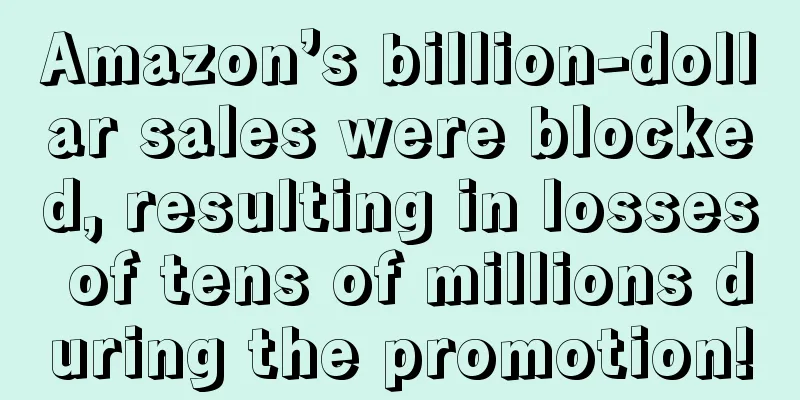Amazon has blocked the delivery window in December. How should sellers respond?

|
It’s the end of the year, and while sales are booming during the peak season, the logistics pressure of cross-border e-commerce is gradually approaching the breaking point! Recently, Amazon’s US site announced a “big move”: from December 15 to December 31, 2024, the delivery window of the distribution center will be completely blocked , which made many sellers feel nervous. What's going on with this wave of restrictions? According to the official announcement, Amazon has imposed strict restrictions on all its U.S. distribution centers due to the risk of warehouse explosions during the holiday peak period . During the lockdown period, the distribution center will stop accepting newly created shipments until normal operations resume on January 1, 2025 . However, the good news is that this lockdown is not completely "one size fits all". Amazon warehouses will still receive the following two types of goods: ① Shipments that have been created and are in transit, such as shipments created before December 15. ② Parcels that are being delivered, that is, parcels with an estimated delivery time between December 15 and 31. It is important to note that some sellers may encounter a system prompt of "rejection" when creating shipments. This is actually Amazon's prediction based on logistics pressure and does not mean that all warehouses have stopped accepting shipments. In fact, some warehouses can still receive goods normally , and the specific situation shall be subject to the actual operation results. Amazon Timeline and Financial Subsidies
Recovery time: January 1, 2025 Impact: All U.S. distribution centers Subsidy policy: Amazon will provide a subsidy of $0.15 per unit for eligible rescheduled shipments . Conditions for receiving subsidies: 1. The original delivery date must be between December 1 and 14, 2024. 2. The rescheduled delivery date must be after January 1, 2025. The subsidy amount will be applied directly to the remaining deduction of fulfillment fees, which can be regarded as a cost recovery method for sellers who can accept delayed delivery.
Sellers with delivery appointments: Although the goods can be received normally, it is expected that there will be delays in listing them, and they may face warehousing defect fees, which will affect efficiency and costs. What do sellers need to do?Check inventory and plan shipments reasonably Check existing inventory levels to see if there is enough inventory to last until January; Accelerate the delivery of shipments created before December 15 to ensure that the goods can be put on the shelves smoothly; If you have new goods that need to be shipped, you can consider giving priority to warehouses that are still receiving shipments to avoid congestion points. Adjust Q4 operation strategy Adjust advertising budgets and promotion efforts based on inventory conditions to avoid a situation where orders grow too fast but inventory is insufficient; Enable FBM (fulfillment by yourself) as an alternative to fill the gap caused by insufficient FBA inventory; Develop an inventory replenishment and promotion plan for January 2025, and use "New Year Promotion" to strive for a new round of growth. Pay attention to official developments and stay agile Check Amazon backend notifications and account health dashboards in a timely manner to pay attention to the latest updates on warehouse receipt and inventory status; If you encounter a situation where a shipment cannot be created or sent, you can obtain the specific reasons and solutions through the customer service channel. Using subsidy programs to reduce losses If some of the goods are eligible for the subsidy, reschedule the delivery time and take advantage of the subsidy policy of US$0.15 per unit to optimize fulfillment costs. Peak season challenges, how to turn crises into opportunities?Although the warehouse lockdown period has brought considerable pressure, it is also an opportunity to optimize the supply chain for sellers who are prepared in advance. By planning inventory in advance, flexibly adjusting delivery strategies, and effectively utilizing Amazon’s subsidy policies, sellers can not only avoid out-of-stock situations during the peak season, but also take advantage of the January “restocking window” to gain new growth opportunities at the beginning of the new year. On the road of cross-border e-commerce, every challenge is an opportunity for self-breakthrough. In the last month of 2024, I wish you all a great sales season and a smooth transition! 🎉 Today's Share Amazon SP+SB+SD product full strategy at different stages |
<<: Amazon’s new operating rules have been implemented, and sellers must make immediate corrections!
>>: Amazon offers $50 advertising coupons for a long time. How can sellers claim them quickly?
Recommend
Two major e-commerce platforms went bankrupt! Millions of dollars worth of orders have not been completed and buyers are suing!
Benefiting from the explosive growth boosted by th...
What is Kuabei? Kuabei Review
Kuabei is a supply chain financial service platfor...
Amazon PPC advertising is burning money but not generating sales? You may not have set up negative keywords
If you haven’t used negative keywords yet, first o...
What is 7wallarts? 7wallarts Review
7wallarts is a leading canvas art manufacturer in ...
Is the sharp drop in Matson's freight rates related to scalpers? Sellers are calling for price increases amid power restrictions!
In recent days, the hottest topic in the cross-bor...
U.S. consumers abandon shopping carts at high rates: Brand websites need to strengthen payment diversification
According to data released by PYMNTS Intelligence,...
What is Gymshark? Gymshark Review
Gymshark is a UK - based fitness apparel and acces...
What is generationtea? generationtea review
Generationtea specializes in importing tea directl...
What is JollyPay? JollyPay Review
JollyPay was founded in 2017. It is a payment plat...
What is Palmpay? Palmpay Review
PalmPay was founded on January 1, 2019. It is an A...
What is Amazon agency operation? Amazon agency operation review
Amazon agency operation refers to professional Ama...
Amazon launches a new program to help new products get started
Recently, Amazon announced that a major new plan ...
Is the next Amazon hotspot in Europe? What is the way out for cross-border sellers?
1 Amazon US sellers are accelerating their expansi...
Picking up zombie listings and being fined 600,000! The first big seller fined for abusing variants has appeared
Great news, friends. Today, the Federal Trade Comm...
Amazon Promotions-How to Set Up a One-Time Coupon Code
<span data-shimo-docs="[[20,"通过Money Off方式...







![[DNY123 Cross-border Morning News] Shopee event deposit withdrawal approval function is suspended, 74% of Malaysian consumers use cashless payment methods](/upload/images/67e6e42565f3c.webp)

